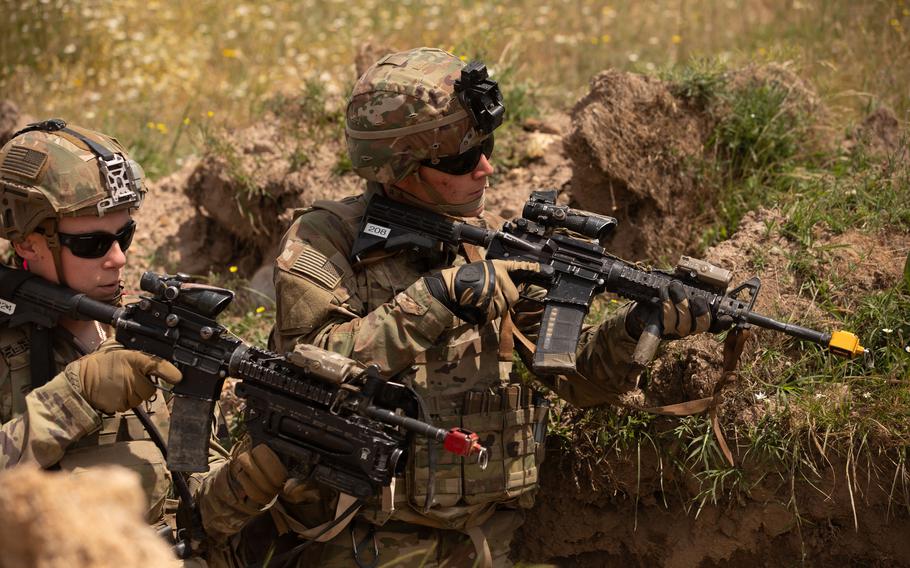
Soldiers from the U.S. Army's 1st Armored Division assault a trench while training alongside Bulgarian forces at Koren Training Area, Bulgaria, May 30, 2025. A U.S. troop reduction in Europe is expected in the future, Estonian defense chief Hanno Pevkur said this week following recent talks at the Pentagon. ( Kyle Kimble/U.S. Army)
STUTTGART, Germany — More details about an anticipated U.S. troop reduction in Europe are expected in the fall, Estonia’s defense chief said this week following recent talks at the Pentagon.
Defense Minister Hanno Pevkur, in an interview Tuesday with Estonia’s ERR network, said he and other Baltic leaders were told by U.S. defense officials that more clarity on plans for American forces could come by October.
“There is an understanding and assumption that the U.S. military posture across Europe will change,” Pevkur said.
While there is no indication how the Baltic states or any other county could be affected, “in Europe as a whole, a reduction is likely to take place,” he added.
Pevkur’s comments came after a visit to the Pentagon, where he held talks with Defense Secretary Pete Hegseth on a range of security matters.
During a joint appearance with defense chiefs from all three Baltic states at the Pentagon, Hegseth lauded Estonia, Lithuania and Latvia for being among NATO’s largest defense spenders on a per-capita basis.
Those countries have all pledged to quickly meet President Donald Trump’s call for dedicating 5% of gross domestic product to military spending.
“Our Baltic allies have long blazed the trail here,” Hegseth said in reference to defense spending by the three countries, which spent decades under Soviet occupation. “This is not new for all of you, and you led the charge on other countries in NATO stepping up.”
For months, allies in Europe have been waiting for more information on a possible reduction in U.S. troops in Europe, but the Pentagon has yet to indicate whether those cuts are a certainty or signaled what form a drawdown could take.
The U.S. now has about 85,000 service members on the Continent, with roughly 20,000 of those deployed on a rotational basis. If the Defense Department reduces its European force posture, it will need to weigh whether to pull back on rotations, cut into its permanently based presence or opt for a combination of the two.
Scaling back the number of short-term unit rotations to Europe could be the quickest solution, but that would mean downsizing the American presence on NATO’s eastern flank, which is a high-priority mission for deterring potential Russian aggression.
Meanwhile, pulling forces from permanent bases could mean giving up strategic infrastructure that’s been built up over the years and used to project power across Europe and beyond.
Hegseth and other leaders have said that European militaries need to carry more of the security burden so the U.S. can dedicate more resources to challenges in the Pacific.
Still, U.S. officials also have said that if a reduction happens, it would be carried out in an orderly manner.
“At NATO, we will work closely with the Pentagon and with our allies to address the impact of any decisions,” U.S. ambassador to NATO Matthew Whitaker told reporters in June.
He said the U.S. will make sure there are “no security gaps in defense capabilities” should it change its force posture.